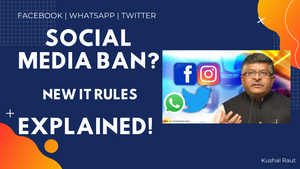
Microsoft on the Go- What's Next? [Part 1]
Microsoft- When you think about it, you think of it as a company standing strong. And, a company who grew steadily. But there was a time when Microsoft would have fallen. No doubt, things are way better now. With time and time steady progression, you might be thinking about what is Microsoft doing? Where are they precisely in the competition? In this Article, you would get to know the same. We are going to tell you about the transition of Microsoft. In other words, how Microsoft has learnt to walk away from the things which aren’t meant for them. So, let's dive deeper into the roots of the Microsoft from the past itself. This Article is divided into two parts.
1] Microsoft's Past State
2] Microsoft's Present State
Why isn’t it coming up? Well, to answer this question in Satya Nadella’s words, I would say “Microsoft is Hitting Refresh” Aah yes, just it means that Microsoft is just figuring out the things they exactly need to do now. Sounds weird but makes sense as you make it through the end of the article.
Microsoft’s Loss
We all know what Microsoft lost with time. They lost their talent of Partnership Muscles. To be honest, this is what they are trying to gain back at present. Another reason was administration fallen into the hands of not so good leaders. The ones who know about Microsoft’s Past would have understood the same. Even if you didn’t, stay with me. Admittedly, they aren’t falling anymore now. They are progressing bit by bit. But what made Microsoft fall back in the past? There are a couple of factors.
Microsoft’s Past Mistake
- Microsoft under Steve Ballmer:
Under the hands of Steve Ballmer, Microsoft took all the right decisions from the business point of view, but wrong regarding engineering. I must say that “Microsoft started the decade with some of the smartest brains working for the company and ended in a huge brain drain.”
Keeping a big size company running well in all sectors and being a Tech Visionary are two different skills. Ballmer had only one. As a result, it caused trouble for Microsoft down the lane. But still, Ballmer didn’t drop the ball financially; he tried to grow it in his ways which were unlike for Microsoft. In short, he was failing at the ethics of Microsoft.
- Isolate Research Products
Indeed, there were so many excellent products which Microsoft created. But most of them didn’t stretch in real life. Demos stayed Demo, without them coming into being as Products.
- Failed Partnerships Muscles
Microsoft always had that plus point of partnership, but eventually, in the middle of the path, they started to lose it. Not only collaboration but they also failed to adapt to the changing times. The same was evident in the Lumia Devices, Zune and many others.
- The late realisation of Capabilities
Microsoft realised it late about their capabilities for hardware. They had the software, but not the hardware. If they had created the hardware, a new expression of Microsoft would have been created. However, they somehow did it presently, but it was late. It would take time to compensate.
Microsoft Under Steve Ballmer
Bill Gates after running Microsoft for 25 years, handed over as CEO to Steve Ballmer. He did a great job with regards to short-term stability. He tripled the Microsoft Sales to $78.64 Billion and doubled the profits. This was where the problem began. As a CEO, the job isn’t only to increase the sales. He exclusively focused on short-term goals for the company and wholly neglected Long-term gains and goals. He was a Businessman more than CEO. Ballmer failed to observe the world and trends being engrossed only increasing the numbers. He missed the trends of Mobile OS, Smartphones, Cloud, Web Search. He kept the focus solely on Windows and Office. That’s it!! Windows & Office.
As a CEO, Steve Ballmer wasn’t able to let go of the existing business model. He didn’t make culture and strategic change into the company. What he did was, executed the prevailing 20th Century Model in a 21st Century. As a result, as aforementioned, Microsoft was somewhere lost for the long-term future.
In the Second Part, we would discuss the Present State of Microsoft. Don't forget to read the Second part. Here's the Link to the same.






Comments